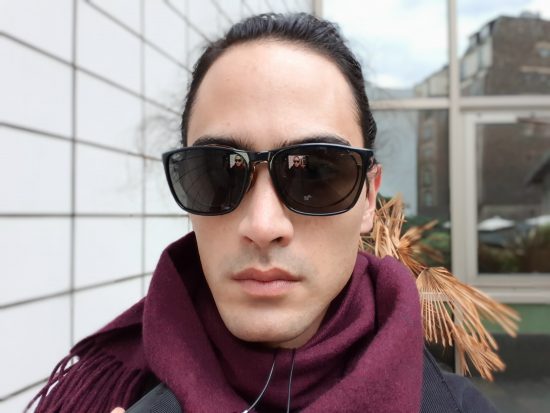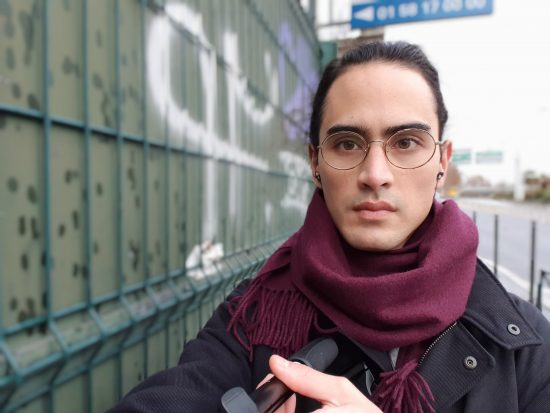The Samsung Galaxy Note 9’s front-facing camera is something of a rare beast in the world of selfie cameras, as it includes an autofocus lens. Add to that a 1/3.6-inch sensor with 8Mp resolution and 1.22µm pixels, 1440p@30fps video, as well as Samsung’s good track record for high-quality smartphone images, and the Note 9 looks like an interesting option for selfie enthusiasts. A device with one of the largest screens launched in 2018, the 6.4-inch display and stylus pen also make the Note 9 a valuable tool for those working on the road. As such, video performance of the front-facing camera could be important for making those business or personal video calls while traveling.
Lab coats on and test charts at the ready, we put the Samsung Galaxy Note 9’s front-facing camera though our industry-standard testing regime, shooting hours of video and thousands of still images. We unveil the scores and bring you our full analysis in this comprehensive review.
Key front camera specifications:
- 8Mp resolution
- 1/3.6″ sensor with 1.22µm pixel pitch
- 25mm f/1.7-aperture lens
- Autofocus for stills and video
- Auto HDR
- 1440p@30fps video
About DxOMark Selfie tests: For scoring and analysis in our smartphone front camera reviews, DxOMark engineers capture and evaluate over 1500 test images and more than 2 hours of video both in controlled lab environments and in natural indoor and outdoor scenes, using the camera’s default settings. This article is designed to highlight the most important results of our testing. For more information about the DxOMark Selfie test protocol, click here.
Test summary


Achieving a DxOMark Selfie score of 92, the Samsung Galaxy Note 9 is a joint leader along with the Google Pixel 3 in our new DxOMark Selfie ranking. Boasting good results for both still photos and video, it’s a solid all-rounder, and the inclusion of an autofocus lens means that the Note 9 often captures sharper multiple group and environmental portraits compared to many competitors. While it’s fair to say that the autofocus performance isn’t perfect, Samsung has noticeably improved its accuracy and repeatability over that of the S9+.
Exposures are also good in most lighting conditions, including wide dynamic range potential in high-contrast scenes and acceptable exposures in very low light. Exposure on the face is the most important aspect in our selfie-cam testing, and although target exposures are slightly high in bright conditions, the results are good overall. HDR images improve over the S9+’s, although some tone compression issues can still lead to a lack of contrast on faces and to noticeable haloing.
In addition to generally good exposure, the Note 9 front camera offers a pleasant color response. Good color rendering and accurate white balance ensure that skin tones have a natural look in most situations.
As we’ve seen recently, Samsung devices handle noise very well in low-light environments, and the Note 9’s front camera offers one of the best compromises between noise and texture that we’ve seen to date. Detail is generally very good, and although very fine details are lost in low-light images, and overall texture could be improved further, the results are excellent.
In Portrait mode, the Note 9’s bokeh simulation effect does a good job of isolating the principal subject, and although some masking errors are visible when there’s a complex background, and the same level of blur intensity is applied regardless of the depth of the background, it’s an acceptable solution overall.
The Note 9’s key strengths for video are (again) good exposure on faces in most situations, good color rendering with accurate skin tones, and generally well-preserved details with low levels of noise. Some exposure instabilities are evident, though, with noticeable steps in exposure adaptation visible under changing lighting conditions. Other opportunities for improvement for video include the autofocus performance, as unnecessary refocusing often occurs, especially in low light.
Photo scores explained
The Samsung Note 9 front camera achieves a total photo score of 96, which is calculated from its scores in tests that examine different aspects of its performance under different lighting conditions. In this section we’ll take a closer look at these image quality sub-scores, analyzing some aspects of the Note 9’s performance versus its key competition.

Exposure and Contrast
Samsung Galaxy Note 9
85
91
The Samsung Note 9 achieves a good overall score for exposure and contrast, thanks to its predominantly accurate exposure of faces in all lighting conditions, and to its wide dynamic range. However, there are a couple of issues that had an impact on the score: for example, when tested under controlled lab conditions, target exposure tends to be slightly bright in all lighting conditions. You can see in the chart below that this is particularly true under very bright conditions between 300 and 1000 lux, where the Note 9 recorded over 60L for brightness (L*), which can lead to a small amount of highlight clipping on both the subject’s face and in parts of a bright background.
Thanks to a wide dynamic range, the Samsung Note 9 is capable of capturing bright highlight detail in tricky high-contrast or backlit scenes, while maintaining good exposure on the face. In the test scene below, the Note 9 records significantly more highlight details in the sky compared to the Huawei P20 Pro, and a little more than the iPhone X. Again, the rendering is not without issue, however, as some tone compression leads to slightly low contrast, which is particularly noticeable on faces. Haloing around the subject is often visible in HDR scenes, too, all of which impacted the Note 9’s score.
Under indoor lighting conditions, both face and overall exposures are generally accurate, and images maintain good contrast.
Exposure is good in extreme low-light conditions down to 5 lux, with images very usable and slightly brighter than those of some competitors (such as the iPhone X). At 1 lux, images are noticeably underexposed, although not so dark that they’re totally unusable.

Color
Samsung Galaxy Note 9
85
105
Color rendering, white balance accuracy, and color uniformity are all excellent in outdoor lighting conditions, but weaker image quality results indoors and in low light affected the Note 9’s overall color score. In well-balanced outdoor lighting, accurate white balance ensures skin tones are pleasant, and good color rendering ensures vibrant reds, greens, and blues without oversaturation.
In high-contrast scenes, however, there is a noticeable yellow/green color cast.
Strong color casts are also evident under indoor and low-light conditions, particular when there is one predominant color in the scene. This is particularly noticeable with red and blue backgrounds, which seriously affect skin tone rendering. (This isn’t really a major color issue, however, as you’re unlikely to be taking many selfies against a solid-colored background.) This phenomenon doesn’t impact the Note 9’s color score too much in our final analysis, but it’s worth being aware of the issue.
Under more normal test conditions with a range of colors in the scene, skin tone rendering is generally very acceptable.
The Note 9 also dropped points in the color category due to non-uniformity, or color shading, which is evident in all conditions. While it’s often the case that smartphone images (from both front and rear cameras) have color shading in low light, color shading is noticeable in Note 9 images even when shot in bright light, and show shifts in color between the center and the edges of the frame in both natural test scenes outdoors and under controlled conditions in the lab.

Focus
Samsung Galaxy Note 9
72
97
A significant advantage of the Note 9’s front-facing camera is the inclusion of an autofocus lens. While the majority of devices offer fixed-focus solutions that provide good sharpness at close range (30cm), and acceptable results at mid-focus (55cm) distances, the Note 9’s autofocus lens makes it possible to achieve sharp images at long range (120cm), too.
In practical terms, faces are usually noticeably sharper in Note 9 images compared to much of its competition when shooting tourist or environmental portraits, where the subject is around 120cm from the camera when using a selfie stick. Implementing autofocus is not without its complications, however, and while the AF is generally very good on the Note 9, some repeatability and stability issues were evident during our tests. The use of a contrast-detection system in the front camera means that the Note 9 suffers some slight instability issues, occasionally focusing on the background instead of the subject both in low light and in high-contrast scenes.
The Note 9 offers extended depth of field in group portraits in which some subjects are further back than the point of focus. Lens design is important here, with wider-aperture lenses often capturing less depth of field, but that’s not the only factor—sensor size and resolution (and therefore pixel pitch) also play an important role. So although the Note 9 features a f/1.7-aperture lens, which is wider compared to the Huawei P20 Pro’s f/2 lens, the Note 9’s significantly greater pixel pitch in its 8Mp sensor (versus the 24Mp in the P20 Pro) means that the P20 Pro records greater depth of field. In default mode, the Note 9’s autofocus system has to decide which face to focus on, and this also has an impact on depth of field. In our tests, we found that it generally focused on the face nearest the camera, which seems like the most sensible solution.

Texture
Samsung Galaxy Note 9
62
85
The Note 9 offers one of the best compromises for detail preservation versus noise reduction among the front-facing cameras we’ve tested so far. The autofocus lens and good sharpness on faces in medium-range (55cm) and long-range (120cm) shots helps the Samsung device achieve a high score for detail. In shots with no subject movement, the Note 9 records good detail in all lighting conditions between 20 lux to 1000 lux. In very low light, its use of fairly slow shutter speeds (for example, 81ms at 5 lux) makes it more challenging to capture sharp shots when there’s some subject movement, with low levels of acutance (below 30%) recorded at 5 and 1 lux. Overall, however, the Note 9’s front camera remains a good device for detail.

So the level of detail captured is high in bright-light conditions, and although fine details are lost in low light, the results are very acceptable compared to the competition’s. The Note 9 displays significantly more edge preservation compared to the Huawei P20 Pro; and while the iPhone X is arguably more detailed, there’s more noise too.

Noise
Samsung Galaxy Note 9
80
90
Excellent noise reduction has been something of a feature of the Samsung devices we’ve tested over recent years, and it’s just as effective on the Note 9’s front camera. Noise is especially well-controlled on faces in all lighting conditions, and although some luminance noise is evident in the corners and backgrounds in low-light environments, the Note 9 handles noise better overall than many of its competitors.
As shown below, we use our new realistic mannequins under controlled test conditions in the lab to assess noise. In bright light (1000 lux), detail is very good, with facial features such as eyelashes clearly defined. The Note 9 loses some details in lower light, but the level of noise is low, with only some minor noise evident in both indoor (100 lux) and low-light (10 lux) images.
We deduct points for noticeable artifacts (obvious image quality flaws). The main penalties we applied to the Note 9 were for halos and tone compression issues in HDR images. We also observed some chromatic aberration, which appears as colored lines along high-contrast edges; a loss of sharpness towards the edges of the frame; and some slight geometric distortions.

Flash
Samsung Galaxy Note 9
72
93
The Note 9 achieves a good score for flash, thanks to effective results both for flash-only and mixed-lighting shots. Using flash as the only light source, exposure on the face and towards the center of the frame is good, although corner shading is noticeable, and leads to a build-up of noise in the corners. White balance leans towards a slight green tint, which affects skin tones, but they remain acceptable. Some minor color shading and color quantization is also visible in flash-only shots. The level of detail is not especially high either, but overall the results are very usable.
Mixing flash with additional tungsten light sources, exposure is excellent on the face and across the frame, with none of the heavy corner shading we observed in flash-only shots. The slight greenish color cast, color shading, and low level of detail remain, but the overall results are superior to those of many competitors.

Bokeh
Samsung Galaxy Note 9
60
75
The Note 9’s Portrait mode is pretty good, offering good noise uniformity across sharp and smooth areas. Results are repeatable, so the effect is consistently applied across consecutive shots, and the system works well in both indoor and outdoor lighting conditions. Depth estimation isn’t perfect, with some masking errors visible when there’s a complex background (such as the dry potted palm in the shot below left), but it does a much better job with simpler backgrounds.
Another opportunity for improvement relates to the blur gradient, as the same amount of blur is applied to all background areas, regardless of their distances from the subject, which can make the effect look a little unnatural.
Video scores explained
The Samsung Galaxy Note 9’s front camera achieves an improved score of 86 points for video, making it a good all-rounder for multimedia creative types. We calculate the overall video score using the following video sub-scores: Exposure (68), Color (78), Focus (80), Texture (57), Noise (81), Artifacts (89), and Stabilization (63).
The device’s key video strengths are accurate exposure on the face in most lighting conditions, with good color rendering and accurate white balance in most test conditions, thus ensuring generally pleasant skin tones. Color rendering in low-light videos could be improved, as the low target exposures result in slightly undersaturated color, but white balance remains acceptable and color shading is reasonably well-controlled.
Target exposures are accurate, recording video under controlled lab conditions at brightnesses between 20 and 1000 lux, so the Note 9 achieves good video exposure scores for both indoor and outdoor lighting conditions. Exposure does drop off quickly in very low-light conditions below 20 lux, however, and these underexposed videos impacted the score a little. That said, the results are respectable, considering the challenging light conditions. There’s no HDR on the Note 9’s front camera videos, either, so it’s best to avoid high-contrast environments.
Some exposure instabilities are evident when continuing to capture video under changing lighting conditions, with noticeable steps in exposure evident, but convergence is relatively quick and overshoots are rare.
Details in videos are well-preserved, with especially good detail captured on subjects close to the camera in all lighting conditions, as well as excellent texture and edge detail in both indoor (100 lux) and bright outdoor (1000 lux) videos. Edge detail remains well-controlled in low-light videos, too, although the level of texture preservation drops off quickly below 100 lux—down to around 30% acutance in very low-light videos, which affected the overall texture score. Instabilities with the autofocus system also affected the texture score, with unnecessary refocusing a problem in both indoor and low-light videos, as the device regularly switched focus to the background.
As with still photos, the Note 9 controls noise well when shooting video with the front camera. It controls both temporal and particularly spatial noise extremely well in indoor and outdoor videos. Although more noise is evident in extreme low-light videos, as you’d expect, it’s well-controlled despite the challenging lighting conditions, and doesn’t adversely impact the viewing experience too much.
Conclusion
As Samsung’s flagship “phablet” features a large 6.4-inch screen, stylus pen, dual rear cameras—and not to mention a high-end price tag, it’s unlikely you’d be buying the Note 9 just for the quality of its front-facing camera. Though if you’re looking for a device in this competitive part of the market, and want good selfies both in still images and on video calls, you can be assured of some of the best results currently available.
Enhancing the autofocus system and the HDR rendering over the S9+, Samsung has improved what was already a top-performing front-facing camera on the Note 9. Neither the autofocus nor the HDR is perfect, so there’s still work to do, but it pushes the development of selfie cameras in the right direction.
Add to that generally good exposure and accurate skin tones on faces, as well as a good compromise between detail preservation and noise reduction in low light, and the Samsung Galaxy Note 9 ends up being one of the best front-facing cameras we’ve tested to date.
Photo Pros
- Accurate exposures on faces with wide dynamic range
- Pleasant skin tone and color rendering
- Well-controlled noise on faces
- Accurate and repeatable autofocus
- Good subject isolation in bokeh mode
Video Pros
- Accurate exposure on faces
- Pleasant skin tone and color rendering
- Good detail preservation in the foreground
- Well-controlled noise
Photo Cons
- Low contrast and tone compression in HDR scenes
- Yellow/green color casts outdoors
- Low levels of detail in low light
- Noise and color quantization using flash
- Slight autofocus instabilities
Video Cons
- Unnecessary refocusing
- Residual high-frequency motion in static handheld scenes
- Exposure instabilities and steps in convergence
- High level of ringing




















































DXOMARK encourages its readers to share comments on the articles. To read or post comments, Disqus cookies are required. Change your Cookies Preferences and read more about our Comment Policy.